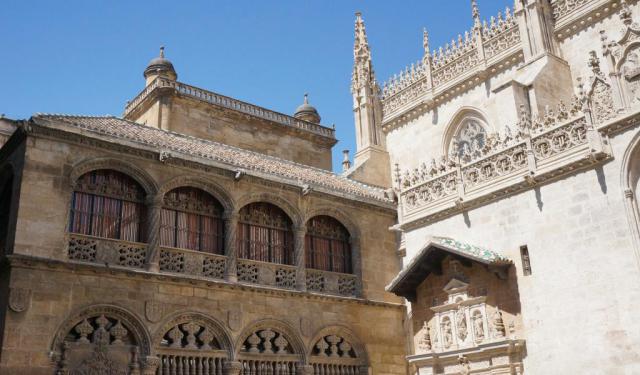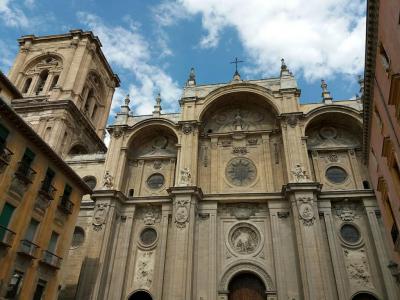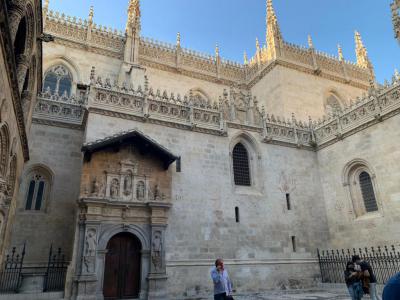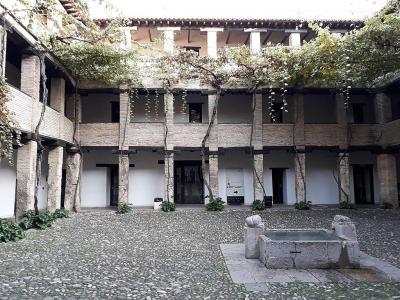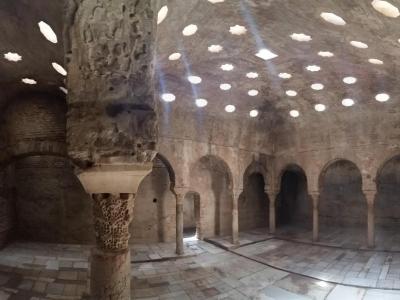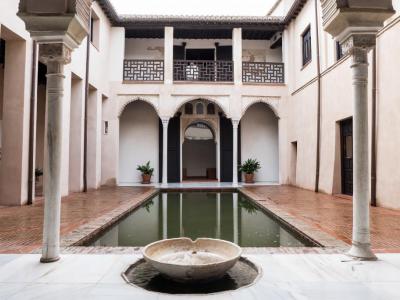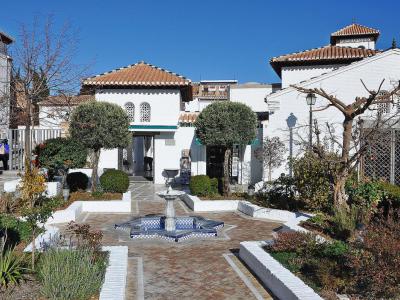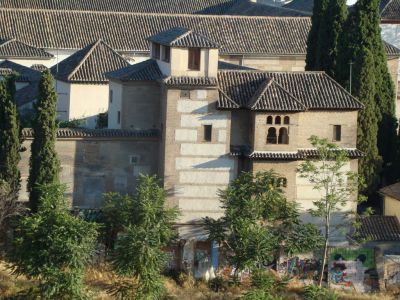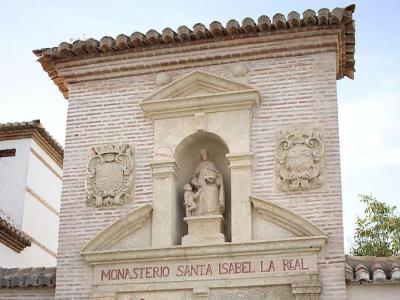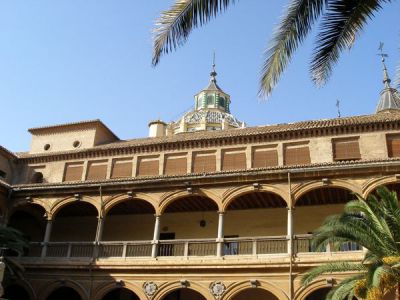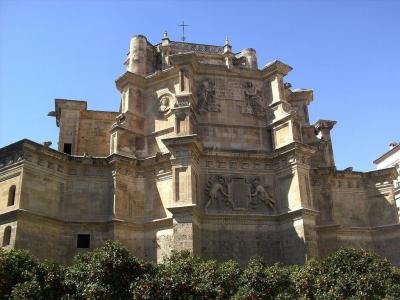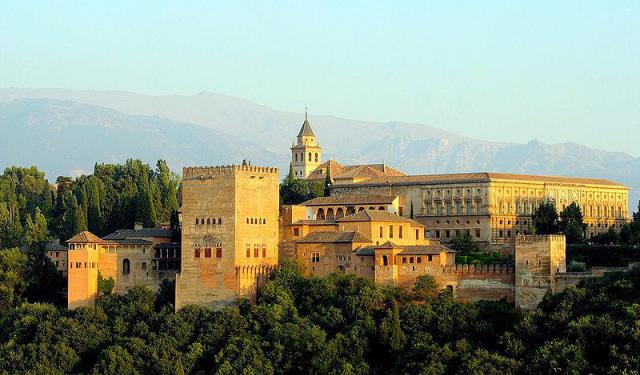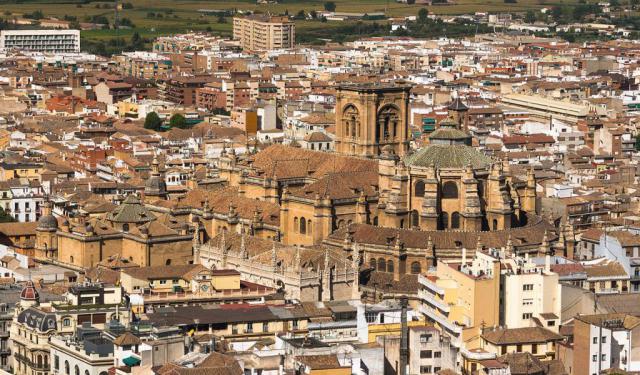Granada's Architectural Jewels (Self Guided), Granada
Over the course of centuries, Granada's architecture has been influenced by four major styles – Moorish, Renaissance, Gothic and Baroque. The city’s most impressive buildings date from the period of Arabic rule and the subsequent Catholic epoch which started after the Moors were displaced in 1492.
From the dazzling majesty of the Alhambra to the awe-inspiring churches and the subtly elegant palaces, the city of Granada is indeed quite fitting the status of an architectural Mecca. Whether you are meandering through the winding streets of the ancient Albaicín district or feasting your eyes on the downtown's post-conquista Christian constructions, there's no shortage of monumental treasures awaiting you around every corner.
Granada’s Moorish architecture impresses with its quiet beauty rather than ostentation or extravagance. This is especially true of the Dar-al-Horra Palace, an understated building that once served as residence for the mother of the last Moorish King of Granada.
Dominating the historical center of the city is Granada Cathedral. Work on this imposing temple began in 1518 and took over 180 years to complete. Another quintessential example of Granada's Gothic architecture is the incredible Capilla Real (Royal Chapel), built between 1505 and 1521.
La Corrala del Carbón, lying at the heart of the Albaicín district, was originally Granada's grain market, also known as Alhóndiga. After the Catholics reconquered the city, the place functioned as a coal ('Carbón') market, hence the current name.
If you're keen to discover these and other jaw-dropping architectural sights and ready to be amazed by their originality and delicacy, embark on this self-guided voyage to the streets of Granada for a truly unforgettable experience!
From the dazzling majesty of the Alhambra to the awe-inspiring churches and the subtly elegant palaces, the city of Granada is indeed quite fitting the status of an architectural Mecca. Whether you are meandering through the winding streets of the ancient Albaicín district or feasting your eyes on the downtown's post-conquista Christian constructions, there's no shortage of monumental treasures awaiting you around every corner.
Granada’s Moorish architecture impresses with its quiet beauty rather than ostentation or extravagance. This is especially true of the Dar-al-Horra Palace, an understated building that once served as residence for the mother of the last Moorish King of Granada.
Dominating the historical center of the city is Granada Cathedral. Work on this imposing temple began in 1518 and took over 180 years to complete. Another quintessential example of Granada's Gothic architecture is the incredible Capilla Real (Royal Chapel), built between 1505 and 1521.
La Corrala del Carbón, lying at the heart of the Albaicín district, was originally Granada's grain market, also known as Alhóndiga. After the Catholics reconquered the city, the place functioned as a coal ('Carbón') market, hence the current name.
If you're keen to discover these and other jaw-dropping architectural sights and ready to be amazed by their originality and delicacy, embark on this self-guided voyage to the streets of Granada for a truly unforgettable experience!
How it works: Download the app "GPSmyCity: Walks in 1K+ Cities" from Apple App Store or Google Play Store to your mobile phone or tablet. The app turns your mobile device into a personal tour guide and its built-in GPS navigation functions guide you from one tour stop to next. The app works offline, so no data plan is needed when traveling abroad.
Granada's Architectural Jewels Map
Guide Name: Granada's Architectural Jewels
Guide Location: Spain » Granada (See other walking tours in Granada)
Guide Type: Self-guided Walking Tour (Sightseeing)
# of Attractions: 10
Tour Duration: 2 Hour(s)
Travel Distance: 3.5 Km or 2.2 Miles
Author: anna
Sight(s) Featured in This Guide:
Guide Location: Spain » Granada (See other walking tours in Granada)
Guide Type: Self-guided Walking Tour (Sightseeing)
# of Attractions: 10
Tour Duration: 2 Hour(s)
Travel Distance: 3.5 Km or 2.2 Miles
Author: anna
Sight(s) Featured in This Guide:
- Granada Cathedral
- Capilla Real de Granada (Royal Chapel)
- Corral del Carbón
- El Bañuelo (Traditional Arab Bath)
- Casa de Zafra (House of Zafra)
- Mezquita del Albaicín (Albaicín Mosque)
- Palacio de Dar-al-Horra (Dar-al-Horra Palace)
- Monastery of Santa Isabel la Real
- Hospital de San Juan
- San Jerónimo Church
1) Granada Cathedral (must see)
Granada Cathedral is a Roman Catholic church. It is the seat of the Archdiocese of Granada and it was built on top of the bones of the Mosque of the City. The construction took place in 1518 after the Christian Reconquest of Andalusia.
The Cathedral was started in The Spanish Renaissance style rather than the Gothic. In 1523 the first architect, Enrique Egas was replaced by Diego de Siloe. The work continued for forty years. Diego planned for a triforium of five naves rather than three. His principal chapel (capilla mayor) was circular, not a semicircular apse.
For 181 years alterations and revisions proceeded under different architects until 1667. Alonso Cano and Gaspar de la Pena introduced Baroque elements to the facade. In 1699 after 181 years, this document of stone might be considered almost complete. But two high towers were planned and never built. The ground underneath was considered unstable.
The Cathedral was meant to be the royal mausoleum but Philip II moved the royal burial site to the palace of El Escorial near Madrid.
The Cathedral was started in The Spanish Renaissance style rather than the Gothic. In 1523 the first architect, Enrique Egas was replaced by Diego de Siloe. The work continued for forty years. Diego planned for a triforium of five naves rather than three. His principal chapel (capilla mayor) was circular, not a semicircular apse.
For 181 years alterations and revisions proceeded under different architects until 1667. Alonso Cano and Gaspar de la Pena introduced Baroque elements to the facade. In 1699 after 181 years, this document of stone might be considered almost complete. But two high towers were planned and never built. The ground underneath was considered unstable.
The Cathedral was meant to be the royal mausoleum but Philip II moved the royal burial site to the palace of El Escorial near Madrid.
2) Capilla Real de Granada (Royal Chapel) (must see)
When Queen Isabella moved into Granada, she was a woman who had found her new home. She was determined to fix it up, to make it her own. Among the first things on her list was to make an addition to that new cathedral that was sitting on the old mosque. The add-on would be her very own chapel, not a little one either. It would be her Main Chapel.
The Main Chapel was constructed at last by 1517. It was built in the new Isabelline style. It is a transition from Gothic to early Renaissance architecture. Isabella planned to stay. By royal decree the chapel was declared to be the future burial site for herself and King Ferdinand. The King did not object.
The chapel is dedicated to Saint John the Baptist and Saint John the Evangelist. The interior is reminiscent of the Monastery of San Juan de los Reyes in Toledo. It has four side chapels in the form of a cross and a Gothic vault. In the center of the transept are the tombs of Isabella and Ferdinand. The tombs are sculpted and raised.
Spoiler alert. The tombs are empty. The royal remains are actually in the crypt below. Since the church is still used for services, the crypt is not always open to visitors. The Catholic kings and queens are joined in this chapel. Their memorials mark the emergence of the coming power and glory of Spain and the brilliant renaissance of Europe.
The Main Chapel was constructed at last by 1517. It was built in the new Isabelline style. It is a transition from Gothic to early Renaissance architecture. Isabella planned to stay. By royal decree the chapel was declared to be the future burial site for herself and King Ferdinand. The King did not object.
The chapel is dedicated to Saint John the Baptist and Saint John the Evangelist. The interior is reminiscent of the Monastery of San Juan de los Reyes in Toledo. It has four side chapels in the form of a cross and a Gothic vault. In the center of the transept are the tombs of Isabella and Ferdinand. The tombs are sculpted and raised.
Spoiler alert. The tombs are empty. The royal remains are actually in the crypt below. Since the church is still used for services, the crypt is not always open to visitors. The Catholic kings and queens are joined in this chapel. Their memorials mark the emergence of the coming power and glory of Spain and the brilliant renaissance of Europe.
3) Corral del Carbón
The Corral del Carbón is located behind the City Hall in the centre of Granada. It is perhaps the oldest complete building in the city that has survived from the Moorish era. Its name translates as ‘coal house’ – and it seems that is exactly what it was used for when Granada was ruled by Emirs. Yusuf I ordered its construction as a warehouse and trading post for coal and other goods. Following the Christian conquest of Granada, it was converted into a theatre, where plays on the lives of Spanish folk heroes like Don Quixote were performed.
The building is constructed around a courtyard, decorated with black and white tiles, and with a water trough at its centre. The courtyard is surrounded by galleries and craft rooms. A pavilion links the main entrance to the central area. The Corral del Carbón is believed to have been used as a tavern for coal merchants, complete with sleeping quarters. Known as ‘caravansaras’ or ‘fundaks’, these hostelries were common in Moorish Spain. The building is now a tourist attraction, open from 9am to 7pm on weekdays, and 10am to 2pm on weekends. Admission is free. The Corral del Carbón also houses a small museum and art shop within its walls.
The building is constructed around a courtyard, decorated with black and white tiles, and with a water trough at its centre. The courtyard is surrounded by galleries and craft rooms. A pavilion links the main entrance to the central area. The Corral del Carbón is believed to have been used as a tavern for coal merchants, complete with sleeping quarters. Known as ‘caravansaras’ or ‘fundaks’, these hostelries were common in Moorish Spain. The building is now a tourist attraction, open from 9am to 7pm on weekdays, and 10am to 2pm on weekends. Admission is free. The Corral del Carbón also houses a small museum and art shop within its walls.
4) El Bañuelo (Traditional Arab Bath)
El Banuelo is a well preserved hammam, an Islamic bathhouse. It can be found on the banks of the Darro in the district of Albaicin. It saw use as a bathhouse until the 16th century. It fell into disuse until the 20th century when it underwent several restorations.
Hammams were common throughout the Muslim world. They were used for ablutions, hygiene and socializing. They functioned very much like the old Roman baths. Many Islamic bathhouses have been uncovered in Granada. Most of the bathhouses were found to be quite simple. The exception to the rule is the lush hammams of the 14th century Alhambra.
The Bañuelo dates from the 12th century, the time of Nasrid rule in Granada. the baths would have been in the old royal citadel in Abaicin before the Alhambra became the center of political power.
The baths were organized by sequential rooms. The first, open to the street, was a reception room with a small pool. A doorway in the room led to rooms with latrines and from there to a changing room. Then came a cold room, a warm room and a hot room. There was no immersion. The patrons were simply doused with warm water.
Hammams were common throughout the Muslim world. They were used for ablutions, hygiene and socializing. They functioned very much like the old Roman baths. Many Islamic bathhouses have been uncovered in Granada. Most of the bathhouses were found to be quite simple. The exception to the rule is the lush hammams of the 14th century Alhambra.
The Bañuelo dates from the 12th century, the time of Nasrid rule in Granada. the baths would have been in the old royal citadel in Abaicin before the Alhambra became the center of political power.
The baths were organized by sequential rooms. The first, open to the street, was a reception room with a small pool. A doorway in the room led to rooms with latrines and from there to a changing room. Then came a cold room, a warm room and a hot room. There was no immersion. The patrons were simply doused with warm water.
5) Casa de Zafra (House of Zafra)
Found at the heart of the historical Albaicin neighborhood, the House of Zafra (Casa de Zafra) is probably the best way to acquaint oneself with the Arab lifestyle in Granada under the Muslim rule. This 14th-century Moorish property, once owned by an aristocratic Andalusian family, has maintained its Arab essence, with many original features still in place. In large part this was possible thanks to the altitude and orography of the Albaicin area, renowned for its winding, narrow and often dead-end streets, which made it easy to withstand contemporary urban reforms.
After the Christian conquest of Granada, Catholic Queen Isabel gave several palatial-type houses, including this one, to her Secretary, Don Hernando de Zafra, as a prebend for his services. After the death of Don Hernando and his wife, the property was donated to the convent of Santa Catalina de Siena, thence popularly known as the Convent of Zafra.
As part of the convent, the Moorish House of Zafra has survived, almost intact, until the early 20th century. In 1931 the entire Convent of Zafra was declared a historic and artistic monument. In 1946 the mayor of Granada acquired the house for the city council, upon which it underwent several restorations, with the latest one being in 2010-2012.
In 1985 the house was declared an Asset of Cultural Interest. Typically of most Arab dwellings, it shows a stark contrast between the relatively simple exterior and the elaborately decorated interior, intended to conceal the comforts of the home, including courtyard with the pool, from strange eyes. The courtyard façades, in turn, reveal unique decorative patterns on arches, columns and polychrome plaster works.
Today, the House of Zafra accommodates Albaycín Visitor Centre, and can be visited for free.
After the Christian conquest of Granada, Catholic Queen Isabel gave several palatial-type houses, including this one, to her Secretary, Don Hernando de Zafra, as a prebend for his services. After the death of Don Hernando and his wife, the property was donated to the convent of Santa Catalina de Siena, thence popularly known as the Convent of Zafra.
As part of the convent, the Moorish House of Zafra has survived, almost intact, until the early 20th century. In 1931 the entire Convent of Zafra was declared a historic and artistic monument. In 1946 the mayor of Granada acquired the house for the city council, upon which it underwent several restorations, with the latest one being in 2010-2012.
In 1985 the house was declared an Asset of Cultural Interest. Typically of most Arab dwellings, it shows a stark contrast between the relatively simple exterior and the elaborately decorated interior, intended to conceal the comforts of the home, including courtyard with the pool, from strange eyes. The courtyard façades, in turn, reveal unique decorative patterns on arches, columns and polychrome plaster works.
Today, the House of Zafra accommodates Albaycín Visitor Centre, and can be visited for free.
6) Mezquita del Albaicín (Albaicín Mosque)
The Mezquita del Albaycín (Albaycín Mosque), also known as The Great Mosque of Granada, was opened in 2003, and is the first mosque built in the city since the Christian Reconquista in 1492.
The Mosque features traditional Arabic style with architectural accents of the Nasrid Empire. Located in Plaza San Nicolás, in the historic Albaycín neighborhood, The Great Mosque is made up of three sections: the garden, the prayer room (which is the mosque itself) and the Center for Islamic Studies.
The prayer section is decorated with sober elements borrowed from Islamic artistic traditions. The mihrab, which marks the direction of prayer towards Mecca, is a replica of the one in the Mosque of Córdoba. The cedar wood panels of the Atlas, carved by hand, contain an ayah from the Qur'an, where some of the divine attributes are named.
The marble panels of different colors are identical to those of the Al Aqsa Mosque in Jerusalem. The large windows of the qibla are copies of those of the Blue Mosque in Istanbul. The fountain and the mosaics in the courtyard, that gives access to the prayer room, have been made by artisans from Fez, Morocco, who have recreated the designs and used same techniques as in Muslim Granada 1000 years ago.
The minaret is a tower of genuinely Albaicine proportions and silhouette. The mosaic inscription with Kufic calligraphy, which can be read under its eaves, is the declaration of faith of the Muslims: “There is no god but Allah. Muhammad is the messenger of Allah." On the ground floor, in the main entrance hall there is a reception desk and a store selling books, crafts and souvenirs.
The Mosque features traditional Arabic style with architectural accents of the Nasrid Empire. Located in Plaza San Nicolás, in the historic Albaycín neighborhood, The Great Mosque is made up of three sections: the garden, the prayer room (which is the mosque itself) and the Center for Islamic Studies.
The prayer section is decorated with sober elements borrowed from Islamic artistic traditions. The mihrab, which marks the direction of prayer towards Mecca, is a replica of the one in the Mosque of Córdoba. The cedar wood panels of the Atlas, carved by hand, contain an ayah from the Qur'an, where some of the divine attributes are named.
The marble panels of different colors are identical to those of the Al Aqsa Mosque in Jerusalem. The large windows of the qibla are copies of those of the Blue Mosque in Istanbul. The fountain and the mosaics in the courtyard, that gives access to the prayer room, have been made by artisans from Fez, Morocco, who have recreated the designs and used same techniques as in Muslim Granada 1000 years ago.
The minaret is a tower of genuinely Albaicine proportions and silhouette. The mosaic inscription with Kufic calligraphy, which can be read under its eaves, is the declaration of faith of the Muslims: “There is no god but Allah. Muhammad is the messenger of Allah." On the ground floor, in the main entrance hall there is a reception desk and a store selling books, crafts and souvenirs.
7) Palacio de Dar-al-Horra (Dar-al-Horra Palace)
The Palacio de Dar-al-Horra was built by the Emirs of Granada in the 15th century, shortly before their rule was ended by Christian conquistadors. The palace was built upon the remains of a destroyed palace, and is the only Muslim palace in the Albayzin to have been at least partially preserved. The name ‘Dar-al-Horra’ translates from Arabic as ‘the House of the Honest Lady’. This is believed to refer to the mother of King Boabdil, the last Arab monarch of Spain, who lived in the palace until 1492, when Granada was claimed by the Catholic monarchs.
Following the Conquest of Granada, the palace was converted by Queen Isabella into the Santa Isabel la Real convent. Whilst the convent still exists within the palace compound, those parts of the original palace that remain are owned by the government, and listed as a national monument. The palace is filled with examples of Nasrid art, which combines Arabic and European artistic styles. The central courtyard is flanked by two porticoes, with a small pool and fountain in the southern portico. The northern portico is notable for its horseshoe shaped arches and ornate Medujar style ceiling, made from wood carved in a geometric pattern.
Following the Conquest of Granada, the palace was converted by Queen Isabella into the Santa Isabel la Real convent. Whilst the convent still exists within the palace compound, those parts of the original palace that remain are owned by the government, and listed as a national monument. The palace is filled with examples of Nasrid art, which combines Arabic and European artistic styles. The central courtyard is flanked by two porticoes, with a small pool and fountain in the southern portico. The northern portico is notable for its horseshoe shaped arches and ornate Medujar style ceiling, made from wood carved in a geometric pattern.
8) Monastery of Santa Isabel la Real
The Monastery of Santa Isabel la Real stands on the Camino Nuevo de San Nicolás, next to San Miguel Bajo church. It was built on the site of Dar al-Horra, a former Moorish palace. It was founded by Queen Isabella of Castile following the conquest of Granada. The monastery was designed in the Gothic style, known locally as ‘Isabella’s style’ due to its popularity with the Queen. It was completed in the 16th century, and bears her coat of arms on the entrance door.
The church’s interior is notable for several unusual items. These include a Mudejar ceiling above the nave, comprised of fretted woodwork in a style associated with Moorish craftsmen. The church also houses the tomb of sculptor Bernardo Francisco de Mora. The font is formed from the remnants of a fountain recovered from the remains of the palace. The statue of the Virgin Mary, along with several wooden crosses seen on the walls of the monastery, is carried by the resident nuns through Granada’s streets for the Easter parade. The nuns that live at the monastery can be heard singing next to the nave each evening at 7pm. They also sell pastries, which can be bought through a revolving window within the church.
The church’s interior is notable for several unusual items. These include a Mudejar ceiling above the nave, comprised of fretted woodwork in a style associated with Moorish craftsmen. The church also houses the tomb of sculptor Bernardo Francisco de Mora. The font is formed from the remnants of a fountain recovered from the remains of the palace. The statue of the Virgin Mary, along with several wooden crosses seen on the walls of the monastery, is carried by the resident nuns through Granada’s streets for the Easter parade. The nuns that live at the monastery can be heard singing next to the nave each evening at 7pm. They also sell pastries, which can be bought through a revolving window within the church.
9) Hospital de San Juan
The San Juan de Dios Hospital is located on the Calle San Juan de Dios, in the centre of Granada. It was founded in the sixteenth century and is named in honour of local folk hero, Juan Ciudad Duarte. A humble bookseller, he devoted his life to caring for the sick and needy of Granada following a religious revelation. Duarte was later canonized, becoming San Juan de Dios, or Saint John of God. With the support of donations from the city’s wealthy middle classes, Juan Duarte founded a charity to provide longer term support for Granada’s vulnerable citizens. It was this fund that paid for the design and construction of the hospital.
The hospital is still in operation, and is the city centre’s largest and most important medical centre. The original hospital building is open to the public at no admission cost, and has become a very popular tourist attraction. This is due to its fine Renaissance architectural design. Features of particular interest include the elegant stone façade, and two colourful patios found within the building, depicting local landscape scenes. The hospital has been expanded in recent times and most medical facilities are now housed in the modern extension buildings.
The hospital is still in operation, and is the city centre’s largest and most important medical centre. The original hospital building is open to the public at no admission cost, and has become a very popular tourist attraction. This is due to its fine Renaissance architectural design. Features of particular interest include the elegant stone façade, and two colourful patios found within the building, depicting local landscape scenes. The hospital has been expanded in recent times and most medical facilities are now housed in the modern extension buildings.
10) San Jerónimo Church (must see)
The San Jerónimo Monastery is located on Calle Rector Lopez Argueta, in the historic center of Granada. It was the first monastery to be built in the city following the Christian conquest of Granada in the Middle Ages. It was first founded in 1492 by Catholics in nearby Santa Fe, but was moved to its current location shortly after the city was retaken by Christian. Construction began on the current building four years later, next to an area known as the Almoravid, which now houses the city’s main hospital. It was built using the demolished Elvira gate during Moorish rule of Granada.
The church was a magnificent building with beautiful painted walls, a stunning celling and altar. The main chapel and transept were created by Jacopo Florentino and Diego de Siloé. The church holds many tributes to Gonzalez Fernando de Cordoba, the "Great Captain" of Spain’s Christian conquistadors, who ended Islamic influence on the Iberian peninsula with the conquest of Granada. The building’s exterior is adorned with his coat of arms, whilst a sepulchre of the military leader can be found inside the monastery, close to the ornate altarpiece.
The church was a magnificent building with beautiful painted walls, a stunning celling and altar. The main chapel and transept were created by Jacopo Florentino and Diego de Siloé. The church holds many tributes to Gonzalez Fernando de Cordoba, the "Great Captain" of Spain’s Christian conquistadors, who ended Islamic influence on the Iberian peninsula with the conquest of Granada. The building’s exterior is adorned with his coat of arms, whilst a sepulchre of the military leader can be found inside the monastery, close to the ornate altarpiece.
Walking Tours in Granada, Spain
Create Your Own Walk in Granada
Creating your own self-guided walk in Granada is easy and fun. Choose the city attractions that you want to see and a walk route map will be created just for you. You can even set your hotel as the start point of the walk.
Alhambra Walking Tour
One of the first places a tourist wants to visit in Granada is Alhambra, the region’s most iconic sight. By far not a typically Spanish attraction, this enormous fortress encompasses palaces, gardens, courtyards, and is the greatest surviving relic of Andalusia’s 800 years of Moorish rule. The sprawling complex sits forbiddingly atop the Darro valley, against a dramatic backdrop of the... view more
Tour Duration: 2 Hour(s)
Travel Distance: 2.0 Km or 1.2 Miles
Tour Duration: 2 Hour(s)
Travel Distance: 2.0 Km or 1.2 Miles
Granada Introduction Walking Tour
The story of the city of Granada does not properly begin until the Umayyad conquest of 711 AD. The Iberian peninsula fell under Moorish rule that would last 700 years and the Jewish settlement of Garnata al-Jahud grew to become Granada of Al-Andalus.
The long Reconquest of Spain finally ended when the Emirate of Granada was ceded by Mohammad XII to the Catholic Monarchs, Ferdinand II of Aragon... view more
Tour Duration: 3 Hour(s)
Travel Distance: 3.5 Km or 2.2 Miles
The long Reconquest of Spain finally ended when the Emirate of Granada was ceded by Mohammad XII to the Catholic Monarchs, Ferdinand II of Aragon... view more
Tour Duration: 3 Hour(s)
Travel Distance: 3.5 Km or 2.2 Miles
Albayzín Walking Tour
The Moorish quarter of Albaycín is a world of its own inside Granada. Mainly, this is due to a strong Islamic vibe still present in the area. The city's oldest district was established by Arabs in the 11th century and to date has retained much of its original charm, manifested in the neat maze of narrow Medieval lanes, shady, intimate courtyards and squares, plus a multitude of well-kept,... view more
Tour Duration: 2 Hour(s)
Travel Distance: 2.3 Km or 1.4 Miles
Tour Duration: 2 Hour(s)
Travel Distance: 2.3 Km or 1.4 Miles
The Most Popular Cities
/ view all
